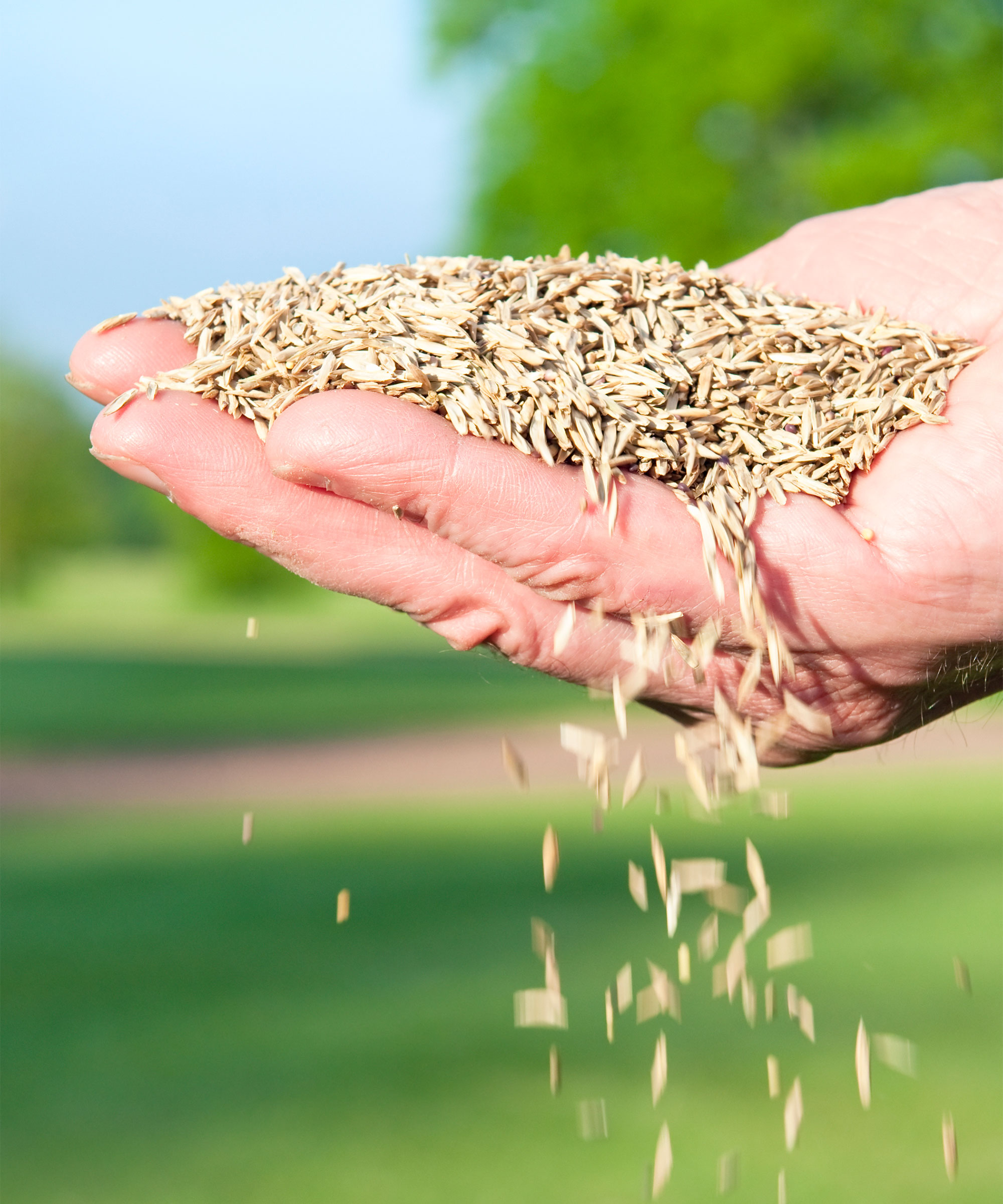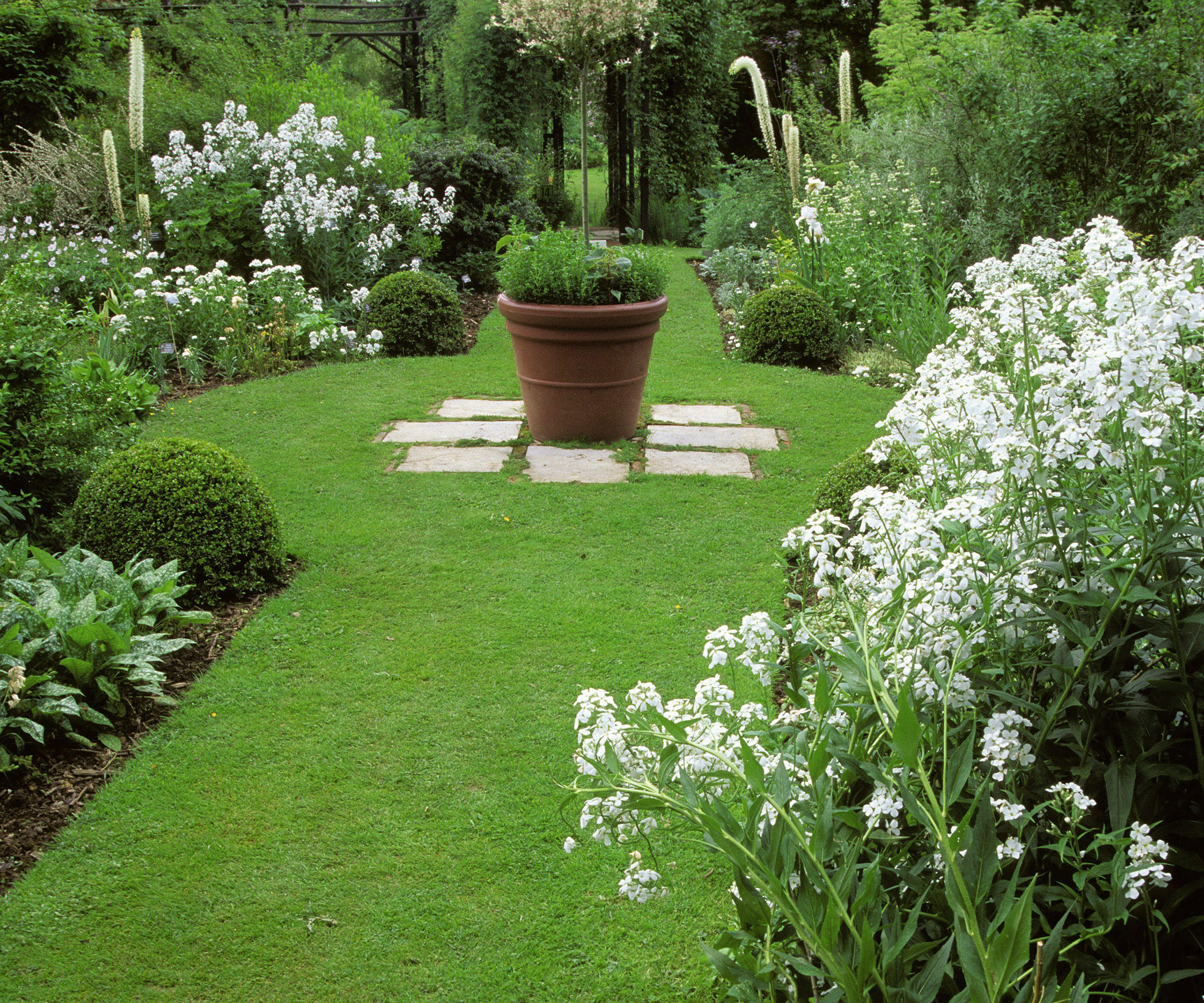How to plant grass seed – 5 expert-approved steps to get a lush and green lawn
Our guide features step-by-step advice from lawn care experts to plant grass seed - all you need to know whether you are starting a new lawn or repairing bare spots

Rachel Bull

A healthy green lawn is the dream of many homeowners. A pristine lawn can make all the difference to the appearance of your backyard and is a year-round feature to enjoy.
Knowing how to plant grass seeds correctly is an important first step in achieving luscious, soft grass. Getting the seeds to germinate successfully gets you off to a great start, after which a good understanding of lawn care keeps your grass healthy and in top shape.
Whether you are sowing a new area of lawn, or repairing patches in grass, here is expert advice to get the timing right and give the grass seed the best chance of germinating and producing healthy green blades.

The tools you need for planting grass seed
Learning how to plant grass seed is a simple job for any gardener - and it requires only essential gardening tools. This is what you'll need:
To reseed small patches, you will simply need:
- A garden fork
- A rake
- Grass seed – Such as the Sotts Turf Builder Sun & Shade mix from Walmart
- Fertilizer
To reseed large areas, it will save you time to invest in:
- A seed spreader – Scotts Turf Builder Seed Spreader is a best seller on Amazon
- An aerator – the Yard Butler Manual Aerator is highly rated on Amazon
1. The best time to plant grass seed

The best month to plant grass seed will depend on the US hardiness zone where you live.
Design expertise in your inbox – from inspiring decorating ideas and beautiful celebrity homes to practical gardening advice and shopping round-ups.
Overall, spring is the best time to plant grass seed, whether that's sowing a whole lawn or fixing those bare patches. Fall is also a good time to plant grass seed for a new lawn. However, once the grass and lawn are more established, you can plant grass seed throughout the summer.
Ryan Farley, CEO of LawnStarter, claims the ideal time for sowing grass seed can depend on the type of grass you are planting.
‘Warm-season grasses prefer being planted in late spring, in my experience—so, during late May or early June,’ says Ryan. ‘Cool-season grasses prefer being planted in later summer or early fall, so anywhere between late August to mid-September.’

Ryan Farley is the CEO of LawnStarter, a lawn care service founded in 2013 and based in Austin, Texas.
2. Choose the best grass seed

Choosing the best grass seed will depend on your location, how much sunlight the lawn receives, and whether it needs to be durable enough to withstand backyard soccer games.
Start by identifying your current grass, as this will give you a great indicator of what likes to grow there. Choosing the same variety makes success far easier in the long run.
Grasses are broadly made up of cool-season and warm-season varieties – which type you choose will depend on your local climate. Cool-season grasses include fescue, ryegrass, Kentucky bluegrass and bentgrass, and these grow better in cooler climates. Bentgrass and fescue are widely used in seed mixes, while ryegrass is particularly tough so a good choice for families.
Also known as southern grasses, warm-season grasses include Bermuda grass, zoysia grass, St. Augustine grass and centipede grass. They thrive in areas with hotter summers and milder winters.
Bermuda and zoysia grasses are widely used throughout the south, while centipede grass is a good low-maintenance choice. St. Augustine is more shade-tolerant than other warm-season grasses.
Many lawns are made up of a seed mix, rather than a single variety. Seed mixtures are generally a blend of species to suit most lawns and guarantee a better strike rate. Options include luxury lawn mixes, shade-tolerant mixes, hardwearing family mixes, and fast-growing varieties. Choose a mix compatible with your climate and garden conditions.
3. Prep the lawn for seeding

Good preparation is the most important aspect of learning how to plant grass seed. Luckily, getting it right is easy.
‘To prepare your soil before planting grass seed, simply till and loosen the soil to create the best growing conditions – you don’t need to put down topsoil,’ says Jeremy Yamaguchi, CEO of Lawn Love.
You can use a garden fork to lightly dig it over to a depth of about 2-3 inches. This will allow new seedlings to take root. Remove any rocks and weeds as you go, but don’t apply weed killer as this will hinder growth. If possible, leave the seedbed for a few weeks and then get rid of any weeds and rake in some lawn feed before sowing.
If you are applying seed to cover patches in a large lawn, it's a good idea to use an aerator, such as this model from Amazon, to punch holes into the ground and pull up small plugs of turf and soil.
Doing this has two benefits. The first is that some seeds will fall into the holes and improve germination. The second is that aerating the soil reduces soil compaction and improves water infiltration.
To give your grass seed a helping hand, it's important to fertilize a lawn. Depending on the product, you can apply pre-seeding fertilizer at the preparation stage, or you can wait until after you have sown the seed to use starter fertilizer. Lastly, rake the soil level before planting the grass seed.

As the CEO of Lawn Love, Jeremy Yamaguchi helps homeowners find quality, reliable lawn care. Specializing in technology and using industry experience, he intends to revolutionize the lawn care industry.
4. Sow your grass seed

For small areas, the easiest way to sow grass seed is by hand. Carefully spread the seeds on the ground evenly and cover them with about a quarter of an inch of soil
‘Sowing grass seed by hand allows for control and precision which is helpful when targeting specific spots that need more seed,’ says Matthew Koch, director of biotechnology, genetics, and seed at Scotts Miracle-Gro. ‘However, it can also be time-consuming and labor intensive.’
For larger areas, use a spreader to sow the seed. Using your hands for large areas can lead to uneven coverage, whereas push rotary spreaders do a great job of applying the seed at a consistent rate.
Press the seeds down by standing on them or using a tool like a roller, because they need a firm seedbed.
‘Pressing grass seed down after sowing can allow for better seed-to-soil contact, stabilization and protection from wind, and increased moisture retention,’ says Mathew Koch. ‘This can easily be done by raking the seeds to lightly cover them with a thin layer of soil.’
Take care not to plant the seeds either too deep or shallow. Bury them too deep and they will take longer to germinate. Too shallow and the seeds will be prone to drying out or being eaten by birds.
You can apply starter feed to fertilize a new lawn once you have planted your grass seed if you didn’t do so before planting, and water immediately.

Born and raised in New Jersey, Dr. Matthew Koch joined Scotts Miracle-Gro in 2012 after finishing his PhD work in plant genetics and breeding at Rutgers University. He began as a scientist in the Biotechnology program and has held a number of leadership roles since. He is currently the director of biotechnology, genetics, and seed, where he oversees the R&D activities of these teams.
5. Water your grass seed

How often you should water grass seed will depend on the weather conditions and climate where you live.
‘Proper watering is essential for the healthy establishment of new grass. For the first two to three weeks, the soil surface should be constantly wet by watering grass seed lightly and frequently,’ says Mathew Koch.
‘Once your lawn is more established, watering can be cut down to about two to three times per week. Finally, once you have a full, established lawn, watering can be scaled back to once a week, depending on weather conditions and soil type.’
Water butts and rain chains are also a great way to collect and reuse any rainwater so that it can be saved to keep lawns hydrated and gardens watered as an eco-friendly garden idea.
FAQs
Should I put topsoil over grass seed?
Do not put top soil over grass seed, but you can add a thin layer of organic matter to help the seed to germinate.
‘Never put topsoil over newly planted grass seed,’ says Jeremy Yamaguchi, CEO of Lawn Love. ‘This won’t provide healthy growing conditions – it will actually prevent the seedlings from sprouting by essentially suffocating them.’
However, if you're wondering if you should use compost on a lawn, there are benefits to doing this. Once the grass is more established then top dressing is something you can do a couple of weeks after fertilizing a lawn if you’re really keen for your grass to grow. Mix together materials like sand, soil loam and peat and apply this to your dry grass.
Will grass seed grow if you just throw it on the ground?
Grass seed will not grow well if you just throw it on the ground. While you might be lucky and some grass seeds will take root, for a healthy patch of grass or lawn, it requires more care and attention to prepare the ground first.
How long does grass seed take to germinate?
Grass seed can take 7-10 days to germinate, depending on weather conditions. However, different types of grasses will take varying times to germinate. You should expect all seeds to germinate within 14-21 days from sowing.
How soon can you walk on grass seed?
It is recommended to avoid walking on newly sown grass seed for at least a month after germination. The lawn should be protected from much footfall until the grass has developed a strong root network, which can take up to eight weeks.
To get the best out of your lawn once it is planted and grown, set it off with stylish lawn edging ideas and care for it with one of the best ride-on lawn mowers. If your grass starts to lose color, then find out when to add lime to lawns to get it back to a luscious, green state.

Melanie has worked in homes and gardens media for two decades. Having previously served as Editor on Period Living magazine, and worked on Homes & Gardens, Gardening Etc, Real Homes, and Homebuilding & Renovating, she is now focusing on her passion for gardening as a Senior Editor at Gardening Know How. As a keen home grower, Melanie has experimented with pretty much every type of vegetable at some point – with mixed results. Often it is the simplest things that elude you, which may explain why she just can't seem to master zucchinis.
- Rachel BullHead of Gardens


